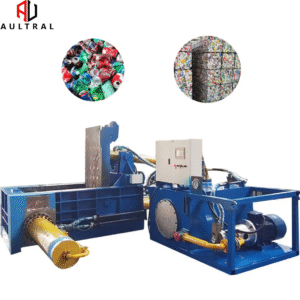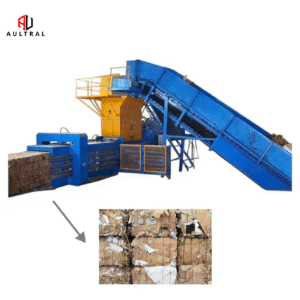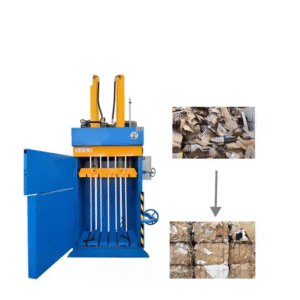In today’s world of rising waste management costs and increasing environmental regulations, choosing the right baler is no longer optional — it’s essential. Whether you run a warehouse, a manufacturing plant, a retail store, or a recycling center, a properly selected baler can save your business money, space, time, and headaches.
But with so many models, sizes, and features available, how do you know which baler is right for you?
This ultimate guide will walk you through everything you need to know — from baler types and key features to industry use cases and purchase tips — so you can make a smart, profitable investment.
🚀 Why Your Business Needs a Baler

Before diving into the types and specifications, let’s understand the core benefits of having a baler:
-
Reduce waste volume by up to 90%
-
Lower waste disposal and transportation costs
-
Keep workspaces clean and safe
-
Support recycling and sustainability goals
-
Increase operational efficiency
Simply put, a baler helps you manage your waste smarter — turning loose, bulky material into compact, easy-to-handle bales.
🔍 Understanding Different Types of Balers
There are several types of balers on the market. Choosing the right one depends on your waste type, volume, and operational needs.
1. Vertical Balers (Downstroke Balers)

-
Best for: Small to medium waste volumes
-
Material: Cardboard, paper, plastics
-
Operation: Load from the front/top, compress vertically
-
Pros: Compact footprint, affordable, easy to use
-
Ideal for: Retail stores, offices, small warehouses
2. Horizontal Balers

-
Best for: Medium to high waste volumes
-
Material: Cardboard, plastic film, metals
-
Operation: Automatic or semi-automatic feed, horizontal compression
-
Pros: Higher throughput, can be fully automated
-
Ideal for: Recycling centers, distribution centers, large factories
3. Manual-Tie vs. Auto-Tie Balers
-
Manual-Tie: Requires workers to tie the bales manually. Lower cost but more labor-intensive.
-
Auto-Tie: Automatically ties bales — ideal for continuous, high-volume operations.
4. Specialty Balers
-
Foam balers, textile balers, can balers — designed for unique materials.
🏗️ Key Factors to Consider Before Buying
Choosing the right baler isn’t just about size — it’s about finding the perfect fit for your workflow and materials. Consider the following:
🔢 1. Type and Volume of Waste
-
What materials are you baling? Cardboard? Plastic wrap? Metal cans?
-
How much waste do you produce daily or weekly?
📏 2. Available Space
-
Do you have enough room for a large horizontal baler?
-
Will it fit through your doors or operate safely in your facility?
⚙️ 3. Manual vs. Automatic Operation
-
Do you have staff to operate and tie bales manually?
-
Would automation save time and labor costs?
💸 4. Budget and ROI
-
Vertical balers cost less upfront, but might be slower.
-
Auto-tie horizontal balers are more expensive, but offer quicker payback in high-volume settings.
🛠️ 5. Maintenance and Support
-
Is local servicing available?
-
Does the manufacturer provide training, warranty, and parts?
🧪 Real-World Use Cases
To help visualize the right fit, here are a few examples:
✅ Retail Store
Waste: Cardboard boxes
Solution: Small vertical baler
Benefits: Saves backroom space, easier recycling, reduces dumpster pickups
✅ Distribution Center
Waste: Mixed plastics, cardboard
Solution: Large horizontal auto-tie baler
Benefits: Efficient, handles high volume, reduces labor
✅ Food Packaging Plant
Waste: Plastic film, packaging materials
Solution: Medium horizontal baler with conveyor feed
Benefits: Automates process, minimizes downtime
⚠️ Common Mistakes to Avoid
Even experienced businesses can make poor buying decisions. Here’s what to watch out for:
-
Underestimating waste volume – leads to overworked balers
-
Choosing based only on price – cheap machines may lack durability or features
-
Ignoring local support – maintenance delays can stall your entire operation
-
Not training staff properly – leads to safety risks and machine damage
📈 How to Calculate ROI on a Baler
Here’s a simple formula to help estimate your return on investment (ROI):
ROI = (Annual Savings – Annual Operating Costs) / Initial Investment
Example:
-
Waste hauling cost savings: $12,000/year
-
Operating costs (labor, electricity, maintenance): $2,000/year
-
Initial baler cost: $15,000
ROI = ($12,000 – $2,000) / $15,000 = 66% in the first year!
✅ Final Checklist: Are You Ready to Choose?
Before you make your final decision, make sure you:
-
✅ Know your waste type and volume
-
✅ Have measured your available space
-
✅ Understand your staff capacity and automation needs
-
✅ Set a realistic budget
-
✅ Compared warranties and support services
🛒 Need Help Choosing? Let’s Talk!
Still unsure which baler fits your business? Our team is here to help.
Contact us today for:
-
✅ A free consultation
-
✅ Customized quotes
-
✅ Site evaluation and recommendations
💡 Conclusion
Choosing the right baler isn’t just a waste solution — it’s a strategic investment in your business’s efficiency, cleanliness, and sustainability. Whether you’re a small retailer or a massive manufacturer, there’s a perfect baler out there for you.
Now that you know what to look for, take the next step. Your waste — and your wallet — will thank you!
